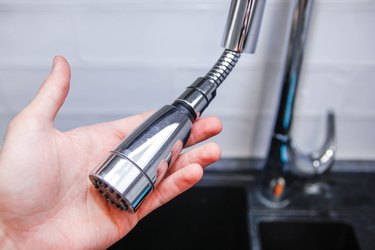
A faucet hose allows you to spray every corner of your sink when washing up, and the weight on the hose lets the faucet firmly retract again when you're done. At least, that's the ideal scenario. If the faucet hose doesn't seem to be the correct length or isn't retracting all the way when you let go, the location of the weight may need to be adjusted. Doing so is a simple and straightforward task that you can complete in just a few minutes.
Locating the Faucet Weight
Video of the Day
Look underneath the kitchen sink to locate the faucet hose. The faucet weight looks like a cylinder clamped to the hose.
Video of the Day
Once you've found the faucet hose and weight, determine whether it has enough room to do its job. The weight needs to be able to fully drop in order to retract the hose back into the faucet handle. If you've pushed anything under the sink recently that could impede its motion, like a trash can or cleaning supplies, you may just need to clear a little room around the hose and weight.
This is the simplest fix when a pull-down kitchen faucet isn't retracting, but fortunately, moving the counterweight on modern faucets is also a breeze. In fact, you may not need any tools to get the job done!
Moving a Faucet Weight
Now that you know where the faucet weight is, it's time to move it and restore your pull-down hose to full functionality. Use a flashlight to get a good look at the type of weight on your faucet hose. It will either have a clip that you push to unlock and lock the weight in place, screws to loosen and tighten or none of the above.
Moen faucet weights have clips. Push up on the clip to snap the hinge and then slide the weight to the ideal location. If you have a model with screws, use a Phillips screwdriver to loosen (not remove!) the screws just enough to let you slide the weight.
If the faucet weight is already moving freely and you see no way in which to hold it in place, a zip tie may have been used under the weight, blocking it from sliding any further down. Simply add a new zip tie that's firmly in place but not choking the hose.
Adjusting the Hose Weight
Now that you know how to move the weight, where should you move it? The answer will depend on whatever sweet spot you can find for your particular hose, so you may need to try a few placements. In general, placing the weight farther away from the sprayer is ideal, as this will give you full range of motion when using it. Otherwise, the weight will block the sprayer from being pulled down all the way.
However, placing the weight too far away from the spray can also impede its motion for proper retraction. This can happen if the faucet hose is quite long or if a high cabinet floor under the sink prevents the weight from dropping all the way. A rule of thumb is to place the weight 15 inches below the bottom of the counter surface, but you can move the weight farther down as long as the hose is long enough.
To do so, start with the sprayer firmly retracted into the handle. Ask someone to hold it in place while you mark the lowest point on the faucet hose before it either hits the floor or starts to curve around. Then, place the weight about an inch above this mark. Test the sprayer to see if it retracts well, and raise the weight up another inch if it doesn't.